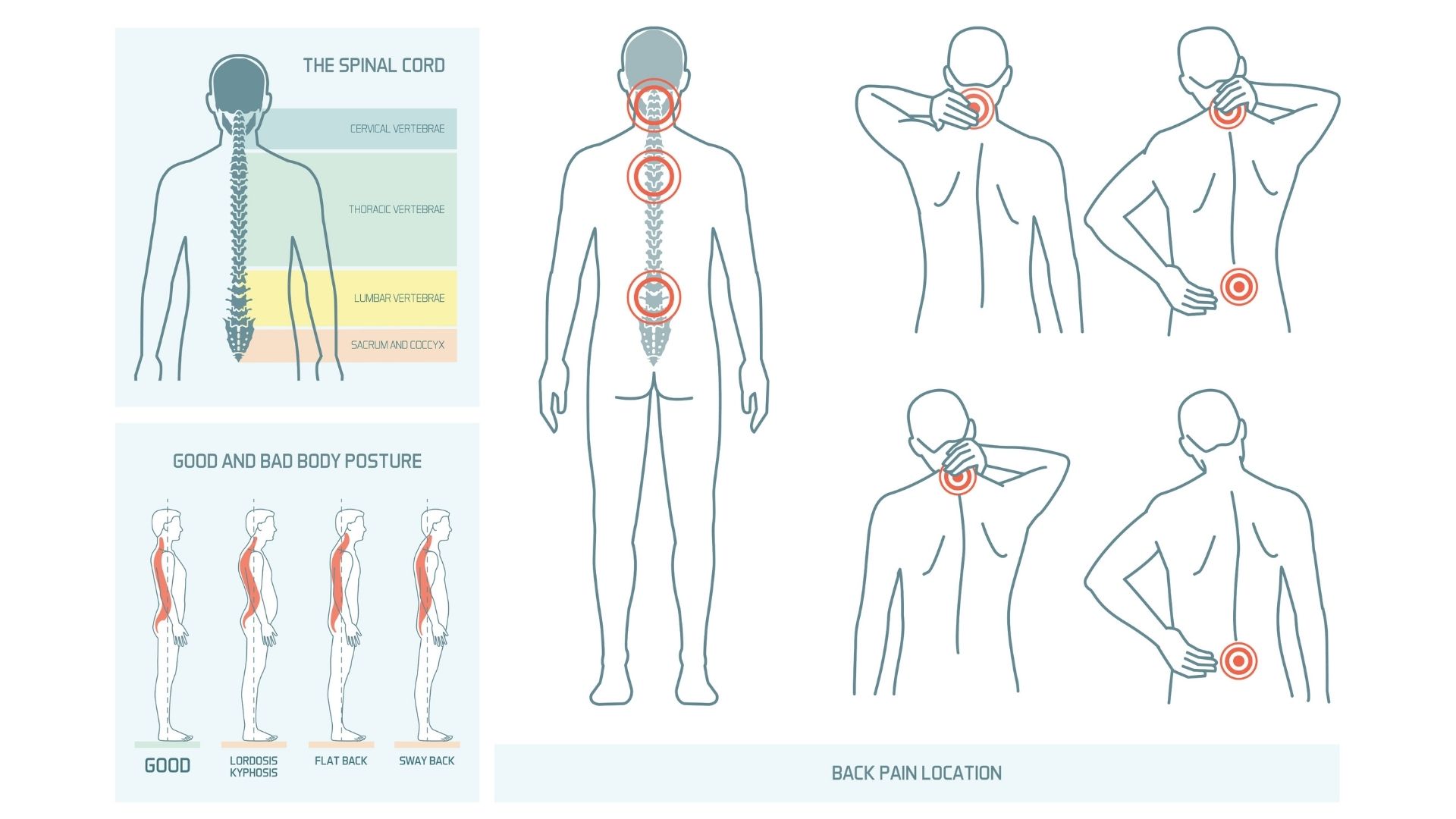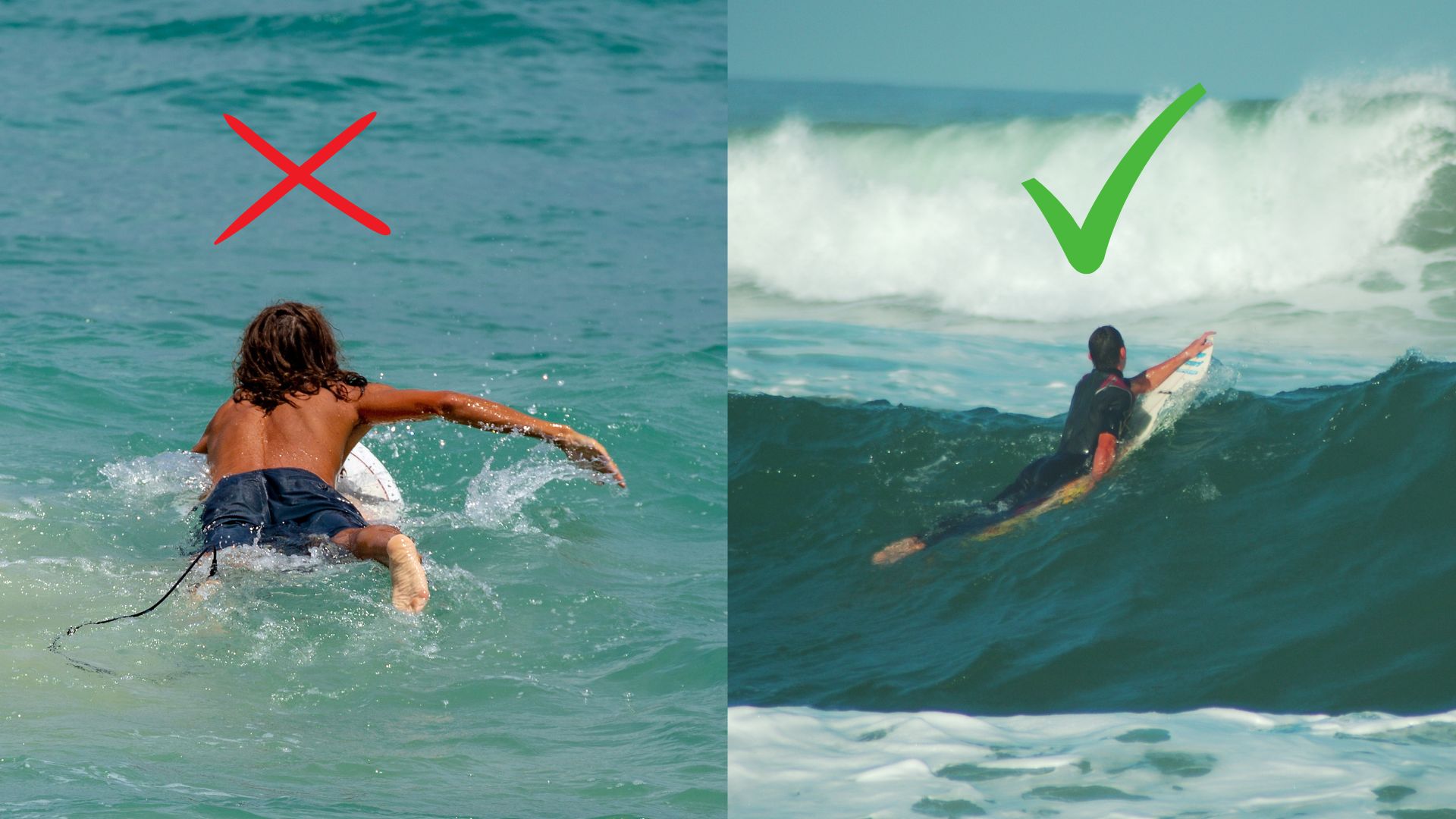While surfing offers a thrilling and rewarding experience, it also involves the risk of injury. Even for surfers who prefer to only tackle small waves, small aches, and pains can flare up after a day at the beach.
Weekend warriors or beginner surfers aside, even legendary surfers, such as Jay Moriarity from the movie Chasing Mavericks (playing on Hulu), often experience intense injuries, like broken bones and torn muscles. Among all injuries, both big and small, a pesky one that can be common is back pain.
Experiencing back pain after surfing is not uncommon, and there can be several reasons for it. Surfing is a physically demanding sport that engages various muscles and puts stress on the body.
Common Reasons for Back Pain After Surfing Include:
Muscle Fatigue: Surfing requires the use of core muscles, back muscles, and shoulders for stability and balance while paddling and riding waves. The repetitive motions and prolonged use of these muscles can lead to fatigue, which may result in back pain.
Overexertion: Surfing can be an intense activity, especially if you are a beginner or not accustomed to the physical demands of the sport. Pushing yourself too hard without proper conditioning can strain the muscles and lead to back pain.
Poor Posture: Maintaining the correct posture while surfing is essential for preventing injuries. If your posture is incorrect, it can put extra stress on your back and lead to pain.
Impact or Falls: Surfing involves navigating through waves and occasionally experiencing wipeouts or falls. These sudden impacts can jolt the spine and cause back pain, especially if you land awkwardly.
Lack of Warm-up: Surfing without warming up properly can increase the risk of muscle strain and injury. It’s crucial to engage in some stretching and warm-up exercises before hitting the waves.
Underlying Back Conditions: Pre-existing back conditions such as herniated discs, muscle imbalances, or spinal issues may be exacerbated by the movements and stresses involved in surfing.
Why Surfers May Suffer from Back Pain
The nature of surfing is usually to blame when surfers start to feel chronic back pain. However, aside from surfing, there are other reasons for back pain to flare up. Before pinning the blame on surfing alone, it is essential to evaluate other possible causes of your pain.
For example, undiagnosed spinal conditions, like scoliosis or herniated discs, can be the cause of back pain in some surfers. You should consult with a doctor to rule these causes out.
However, if you do not have any underlying spinal conditions, there is a good chance that surfing is the cause. This is because surfing requires a person to work his or her muscles in odd and sometimes awkward positions, all of which can cause a strain on different areas of the back.
Strain on the Lower Back
The lower back is often where back pain is first felt in surfers, and this can almost always be blamed on the position used for paddling. This is because, when paddling on a surfboard, the surfer must lay face-down but also keep his or her head up. At the same time, the surfer also must use his or her arms to paddle through the water.
Paddling Motion: Over time, this highly active repetitive motion of paddling can lead to fatigue and strain on the muscles of the lower back, also known as the lumbar spine.
Balancing and Stabilizing: Surfing requires constant adjustments in balance and stability to stay on the board and ride waves. The muscles in the lower back and core play a crucial role in maintaining balance and stability while riding the surfboard, especially during maneuvers and turns.
Hyperextension of the Spine: During the paddling phase and while riding waves, surfers often arch their backs to lift the upper body. This motion can lead to hyperextension of the spine, putting extra pressure on the lower back.
Impact and Wipeouts: Surfing involves navigating through waves and experiencing falls and wipeouts, which can lead to jolts and impacts on the body. When landing awkwardly or forcefully in the water, the spine can be subjected to sudden compression forces, potentially leading to lower back strain.
Prolonged Time in the Water: Surfing sessions can last for extended periods, especially for dedicated surfers. Spending a long time in the water and maintaining the surfing position can cause fatigue in the lower back muscles.
Cold Water: Cold water can cause the muscles to tighten and become less flexible, making them more susceptible to strain and injury during surfing.

Strain on the Middle and Upper Back (Thoracic)
While back pain in surfers is usually felt in the lower areas of the spine, there are plenty of cases where pain and tension are felt further up.
The shoulders and thoracic area of the back, in particular, can become extremely tight and tense after long and strenuous sessions in the water where a lot of paddling has taken place.
Some of the primary reasons for strain on the middle and upper back while surfing include:
Paddling Motion: Paddling is a fundamental part of surfing, and it involves repetitive movements of the arms and upper body. The paddling motion can strain the muscles in the middle and upper back, especially when paddling against waves or currents.
Rotational Movements: Surfing requires rotational movements of the upper body to navigate the waves and make turns. These movements can put stress on the muscles and joints of the middle and upper back.
Prolonged Torsion: Maintaining an upright or slightly arched position while surfing and constantly adjusting body positioning to stay balanced can lead to prolonged torsion in the middle and upper back, leading to strain.
Forceful Maneuvers: Executing maneuvers such as bottom turns, cutbacks and aerials require forceful actions, which can put additional strain on the middle and upper back muscles.
Balancing and Stabilizing: Surfing demands constant adjustments to balance and stabilize the body on the board, engaging the muscles in the middle and upper back to maintain posture.
Carrying the Board: Carrying a surfboard to and from the water, especially larger and heavier boards, can strain the muscles in the middle and upper back, especially after a long session.
How to Prevent Back Pain After Surfing
If you are already suffering from back pain after a surf, you may think that it is too late to slow the progression of the pain.
However, whether you do or do not already have back pain, know that there are plenty of steps you can take to prevent the pain from starting or getting worse.
Strengthening and Stretching the Back:
Perhaps the best thing surfers can do for their backs is to add a strengthening and stretching exercise routine to their daily lives. Simple strengthening exercises at home or at a gym, such as partial crunches for lower back pain, help strengthen those muscles enough to prevent strain while surfing later.
There are many back-strengthening exercise routines available to follow in online videos and exercise books. Specifically, yoga and pilates routines can work the back muscles in a way that also promotes flexibility and prevents muscle tightness.
In general, you should look for routines that activate your upper and lower back muscles while you perform. You’ll also want to focus on building strong and flexible shoulders, a steady posterior chain, and glute activation to take the load off your back.
(The video below is a game-changer when it comes to your glutes).
Proper Warm-up:
Engage in dynamic stretching and light exercises to warm up your muscles before heading into the water.
Practice Good Paddling Posture:
Be mindful of your posture while paddling. Get your chest off your board, pull your shoulders back, and use your glutes, legs and core for stability.

Take Breaks:
If you’re feeling fatigued, take breaks during your surfing sessions to allow your muscles to recover.
Stay Hydrated:
Dehydration can contribute to muscle cramps and pain, so drink plenty of water before, during, and after surfing.
Listen to Your Body:
If you experience persistent or severe back pain, don’t ignore it. Rest and seek medical advice if needed.
Remember, each individual’s body is different, and if you continue to experience back pain or it becomes severe, it’s essential to consult a medical professional for a proper evaluation and personalized advice.
What to Do If You Have Back Pain After Surfing
Surfers who have back pain now do not have to live with the pain forever. While prevention is key to alleviating pain, there are still some things you can do to minimize the pain you already have.
Muscle Massaging
Whether you do or don’t have back pain after surfing, taking time to massage your back muscles can help prevent or lessen aches. You can either massage your back yourself with your hands or use a foam roller to help your muscles relax and loosen. Doing this will not only make your back more flexible but also prevent pain due to tightness that usually comes up a few hours after a surfing session.
Hot and Cold Therapy
In general, heat therapy is best used for chronic pain, and ice therapy is best used for acute injuries. That being said, surfers with ongoing back pain may find hot therapy useful while those who experience mild back soreness may prefer cold therapy.
For the prevention of back pain, you can use a combination of both hot and cold therapy, typically by using cold therapy first in the likes of a portable ice bath and hot therapy second with the likes of a portable sauna.
Benefits of Heat Therapy
Muscle Recovery: Surfing engages numerous muscle groups, leading to fatigue and soreness. The heat from saunas promotes blood circulation, aiding in the delivery of oxygen and nutrients to tired muscles while flushing out metabolic waste products, thereby accelerating recovery.
Injury Prevention: Surfers often face the risk of injuries, ranging from strains and sprains to overuse injuries. Regular sauna use helps improve flexibility, joint mobility, and tissue resilience, reducing the likelihood of injuries both in and out of the water.
Immune Support: The immune system can take a hit from frequent exposure to cold water and fluctuating temperatures. Sauna sessions stimulate the production of white blood cells and enhance immune function, helping surfers fend off illnesses and stay healthy year-round.
Stress Relief: Surfing is a demanding sport that requires focus, determination, and composure. Saunas provide a sanctuary for surfers to unwind, alleviate stress, and promote mental clarity, fostering a balanced mind-body connection essential for peak performance.
Increased Flexibility: Heat therapy, including sauna sessions, gently raises the body’s core temperature, facilitating muscle relaxation and improving flexibility. This enhanced flexibility translates to fluid movements and reduced risk of strains or sprains.
Enhanced Circulation: Heat causes blood vessels to dilate, promoting circulation and nutrient delivery to muscles, tendons, and ligaments. Improved circulation aids in recovery post-surfing and supports overall cardiovascular health.
Get Professional Help
Physical Therapist: Physical therapists are skilled in evaluating and treating musculoskeletal conditions through exercises, manual therapy, and other techniques to improve mobility and reduce pain.
Chiropractor: Chiropractors specialize in diagnosing and treating mechanical disorders of the musculoskeletal system, especially the spine. They use hands-on manipulation and adjustments to alleviate pain and improve function.
Osteopath: Osteopaths are doctors who take a holistic approach to healthcare, focusing on the musculoskeletal system’s alignment and function. They can provide manual therapies and other treatments for back pain.
Rheumatologist: If your back pain is related to inflammatory conditions like ankylosing spondylitis or arthritis, a rheumatologist is a specialist to see. They can diagnose and treat these types of conditions.
Time for Recovery
Just like any other athlete, a surfer should give his or her body time to rest and recover before and after surfing. If you go surfing in multiple back-to-back sessions, you may put too much strain on your back muscles, not to mention your arm, core, and leg muscles too. When you already suffer from back pain, the rest and recovery process is even more important to prevent your pain from getting worse.
Age can come into play when you are deciding how much time your body needs to recover after surfing. This is because, as we age, our musculoskeletal systems naturally change and often become more susceptible to injuries. Older-aged surfers may also see their back pain reduce when they spend more time in recovery.
Summary
Back pain is, literally, a pain in the back, and is a common problem shared by many surfers. After all, surfing is an intense sport, and surfers are subject to pain and injuries just like all other athletes. However, back pain in surfers can be prevented and even treated when you correct your surfing technique, focus on strengthening and stretching your back between surfing sessions, and give your body plenty of time to recover post-surfing.


